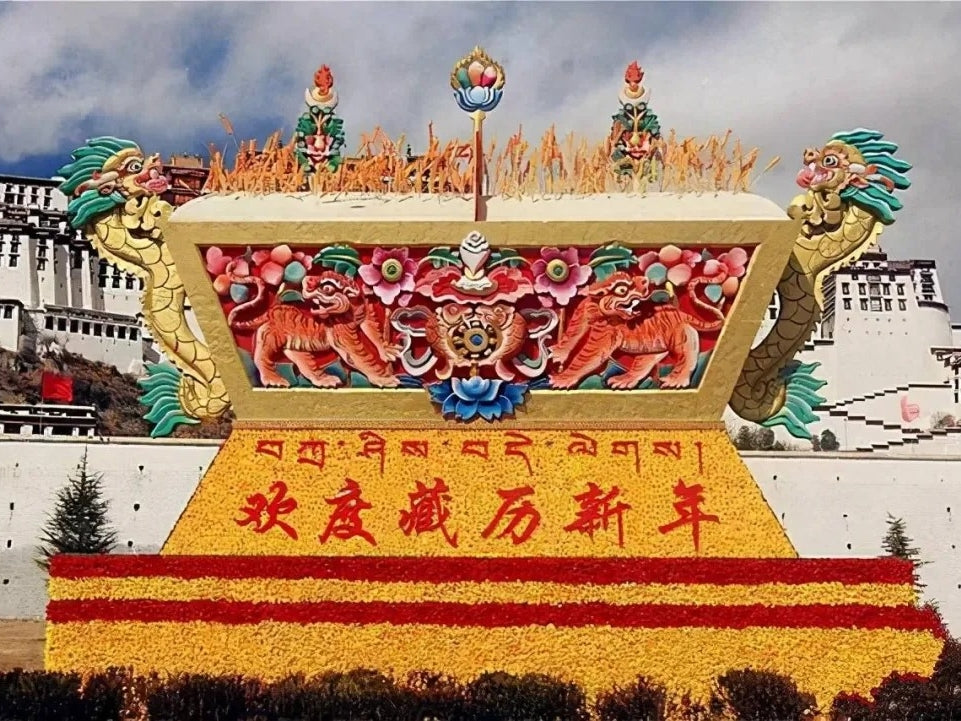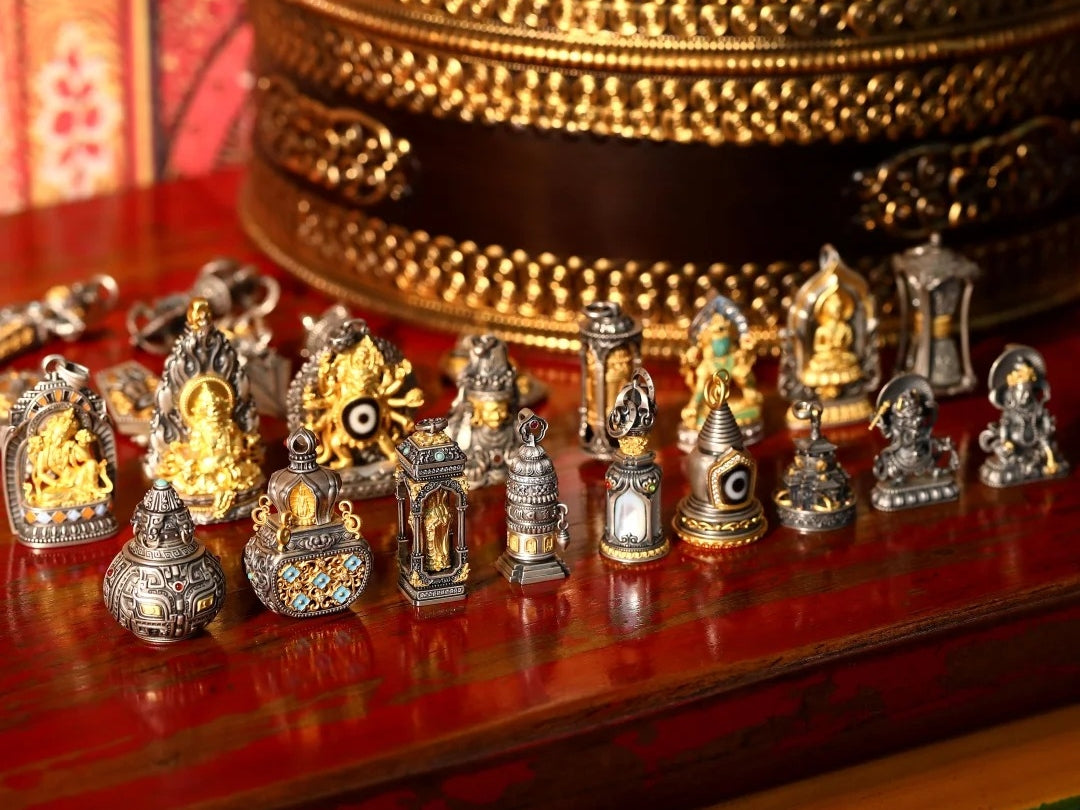Hayagriva — known in Chinese as 马头明王 and sometimes called the Horse-Headed Vajra or Horse-Headed Avalokiteśvara — is one of the most striking and dramatic figures in tantric Buddhism. With one or three horse heads rising from a crown of flames, multiple arms, and a fierce, almost warlike posture, Hayagriva stands out in Thangka paintings and temple sculptures. Yet beneath that fearsome exterior lies a set of symbolic meanings rooted in compassion: Hayagriva’s wrath is a form of skillful means used to destroy ignorance, remove obstacles, and protect practitioners and communities from harm.
This article unpacks Hayagriva’s iconography, his traditional role in Tibetan and East Asian practice, the function and symbolism of his mantra, and the ways his image and mantra have traveled into contemporary life — including art, amulets, and jewelry.

A bold icon: what Hayagriva looks like and why
Hayagriva’s visual vocabulary is unmistakeable. Common elements include:
-
Horse head(s) atop the crown or emerging from the hair, often arranged in a row of three. The horse imagery evokes speed, clarity, and the power to trample ignorance.
-
Wrathful expression: flaming hair, bulging eyes, and bared fangs signal a fierce compassion that confronts obstacles directly.
-
Multiple arms and ritual implements: knives, vajras, tridents, and other ritual tools appear in his hands. These are not random; each tool symbolizes a method for cutting through specific mental afflictions or dispelling negative forces.
-
Animal and crown motifs: snakes, tiger-skin skirts, and skull crowns commonly appear, referencing Hayagriva’s mastery over danger and death, as well as his role as a protector against malign influences.
This vivid imagery functions on multiple levels. To a practitioner, the wrathful form represents an inward, psychological process — an inner force that confronts deeply ingrained confusion. To a community, Hayagriva can serve as a guardian, deployed in rituals aimed at averting natural disaster, disease, or hostile spirits.

Historical and ritual roles
In Tibet, Hayagriva is a central yidam (meditational deity) for certain tantric lineages. Ritual specialists and communities have invoked Hayagriva in times of crisis — drought, floods, epidemics — reciting his liturgies and performing protective rites to restore balance. In some traditions Hayagriva is viewed as a fierce emanation linked to Avalokiteśvara (the bodhisattva of compassion) or as an emanation connected with Amitābha, depending on local lineage histories.
Hayagriva is also important in Japanese esoteric Buddhism (Shingon), where he appears in temple iconography and ritual contexts. Across these cultures, the deity’s power is expressed as both social protection (community rites) and personal practice (meditation, mantra recitation).

The mantra: meaning and symbolic power
Mantras associated with Hayagriva vary by region and lineage, but their function is consistent: they are vocalized forms of focused intention. A commonly cited short form is “Om Hayagriva Hum Phat”, though longer liturgical formulas appear in traditional practice manuals. The mantra’s purpose is symbolic and practical — it serves to:
-
Focus the mind in a concentrated, disciplined way.
-
Invoke protection from external and internal threats (clearings of fear, illness, or malign influence).
-
Express the vow to transform ignorance into wisdom — mirroring Hayagriva’s symbolic act of “devouring” ignorance.
Because Hayagriva practice has tantric elements, longer ritual protocols, visualizations, and mantra recitations are traditionally taught under the guidance of an experienced teacher. For those drawn to the Hayagriva mantra in everyday life, short respectful practices — such as a few recitations before a difficult task — are a common and accessible way to acknowledge the deity’s symbolic help without entering into complex ritual.

Hayagriva’s modern impact: art, amulets, and jewelry
Today Hayagriva’s distinct look has crossed into popular devotional and artistic spaces:
-
Thangka and prints: Contemporary artists continue to render Hayagriva in richly colored scroll paintings that are used in temples and home shrines.
-
Amulets and pendants: Small pendants and amulets depicting Hayagriva are crafted in brass, silver, and crystal. Because the imagery reads as protective, these pieces are often worn as talismans — especially by those who seek a symbolic reminder of courage and resilience. If you’re interested in a Hayagriva pendant, look for respectful craftsmanship and clear information about how the piece was made and whether it was blessed in a ritual context.
-
Creative reinterpretations: Designers sometimes adapt Hayagriva motifs into contemporary jewelry or graphic art — simplified line drawings, small reliefs on rings, or stylized pendants that retain the deity’s essential symbolism while fitting modern aesthetics.
Practice notes and respectful engagement
Hayagriva’s practices belong to complex ritual systems. If you’re curious about working with his imagery or mantra:
-
Learn the context. Read or ask about the lineage, function, and traditional etiquette surrounding the deity.
-
Respect ritual depth. Intensive tantric practice is traditionally transmitted by a qualified teacher; for many Western practitioners, short, respectful recitations and contemplative reflections are a sensible starting point.
-
Treat objects with care. Amulets, Thangka images, and hand-painted pendants are cultural and spiritual objects; handle them with basic reverence, avoid exposing painted images to direct sun or moisture, and store consecrated pieces respectfully.
Final thought
Hayagriva’s combination of thunderous imagery and compassionate aim — to strip away fear and reveal what is true — is part of what makes him compelling across cultures and centuries. Whether encountered in the vivid strokes of a Thangka, the burnish of an antique amulet, or the discreet shine of a pendant, Hayagriva invites a meditation on courage: not aggression, but the fierce clarity needed to face what blocks a more compassionate and awake life.




